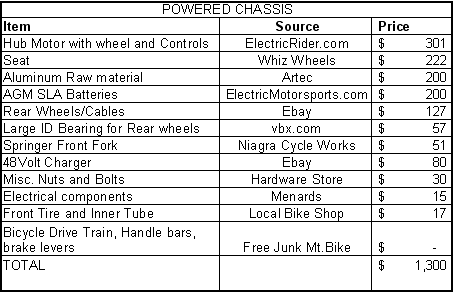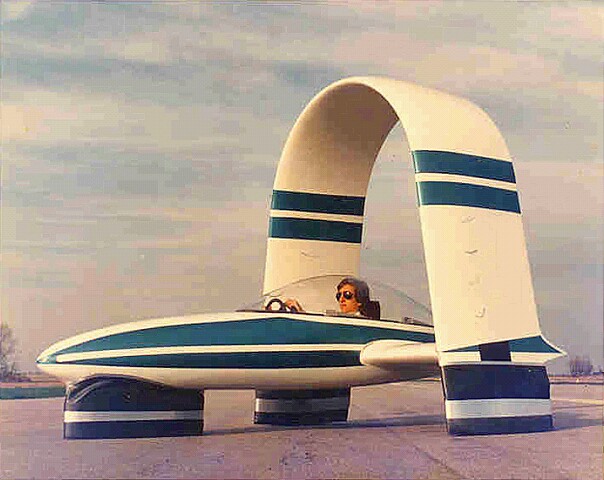
Jan. 17 Begin Internet BenchMarking
Patent Research on the Sail Car (4117900 and 3804428)
The Leading Edge Aerodynamic Design of Ultra-Streamlined Land Vehicles by Goro Tami and the Pumpkin Seed Solar Car Racer
Python Trike
Protohippus Trike
Research on Various Land Yatchs including Iron Duck
Rans Sail Trike
Varna Pipeline
Tilting Trikes
FWD recumbents
Electric Hub Motors
Open Source Tilting Trike
FWD recumbent and leaning delta trike
January 21, 2008 Whiteboard Sketch of Sail Car

January 28, 2008 Receive THE LEADING EDGE book on Aerodynamic Design of Ultra Streamlined Vehicles by GoroTamai

Jan. 29, 2008 Scratch and Dent RV-8 Canopies from Todd's Canopys Arrive

Feb. 5, 2008 Telescoping Rear Wheels and room for Batteries

Feb. 7, 2008 Wind/Electric/Human HyBrid Concept
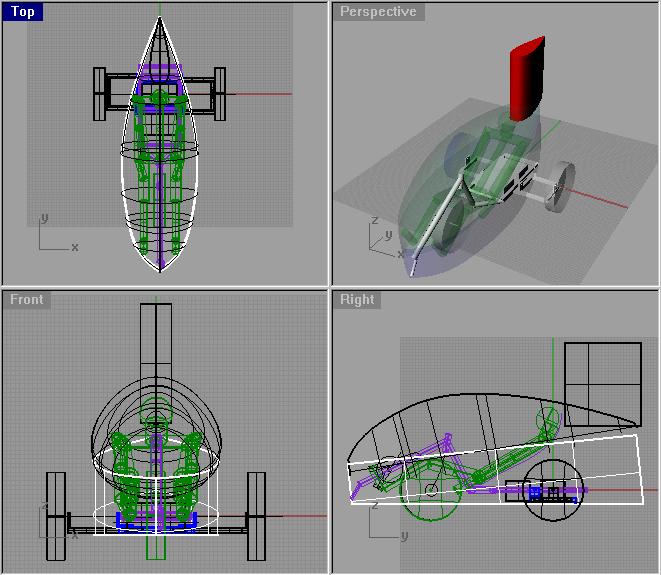
Feb. 8, 2008 Center of Gravity and Design Concerns

Feb. 8, 2008 Areodynamic Design Decisions

Feb 7, 2008 Jeff Mass of Diverse Dimensions Uses Faro Arm to Digitize Canopy

Feb. 12, 2008 Design Updated With New Canopy Data and Clearance for Pedals with Front Wheel
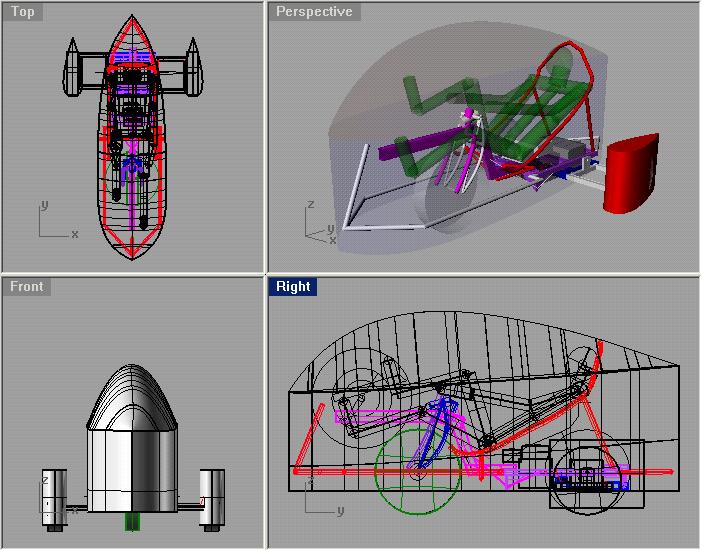
Feb. 24, 2008 Full Scale Mock-Up
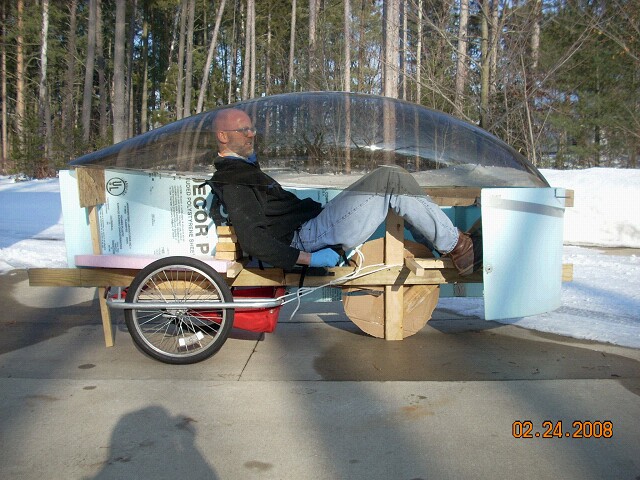
March 3, 2008 Aluminum raw material and springer fork PN 27436 arrive
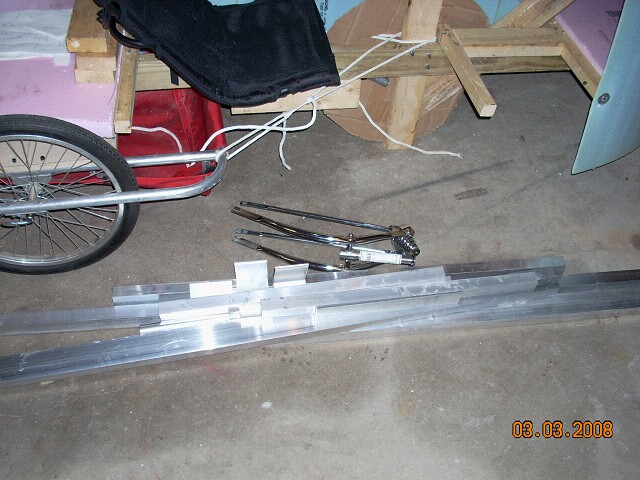
March 4, 2008 Springer Fork Widened to fit Hub motor

March 25, 2008 Weldments, Electrical Components and Wheels on Floor
48V, 20Amp-Hour SLA Battery: 60#
Geely Moped Wheels: 28# (14#/wheel)
Aluminum Frame: About 25#
1,440 W Crystalye Hub Motor and controls from ElectricRider.com: 20#
Springer Fork: 4.7#
Whiz Wheels Seat: 3.5#
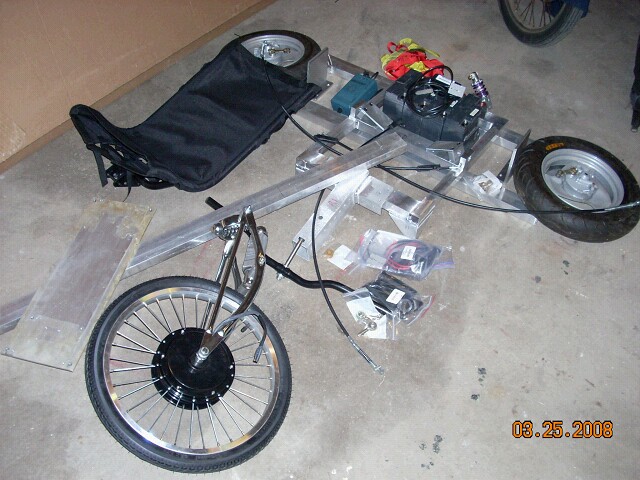
Starting to Assemble 3-26-08
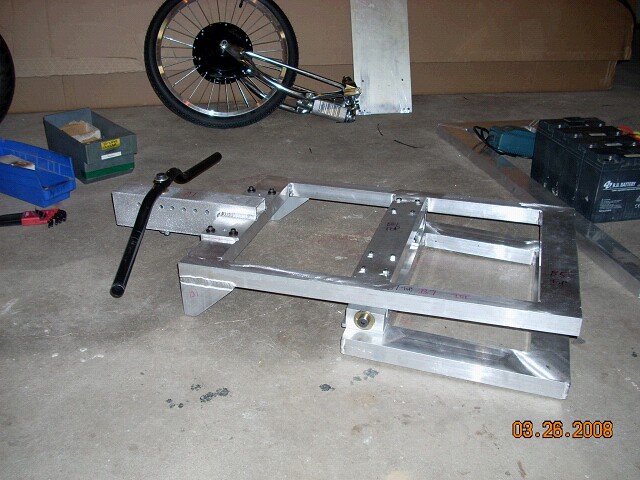
Front End Complete 3-31-08
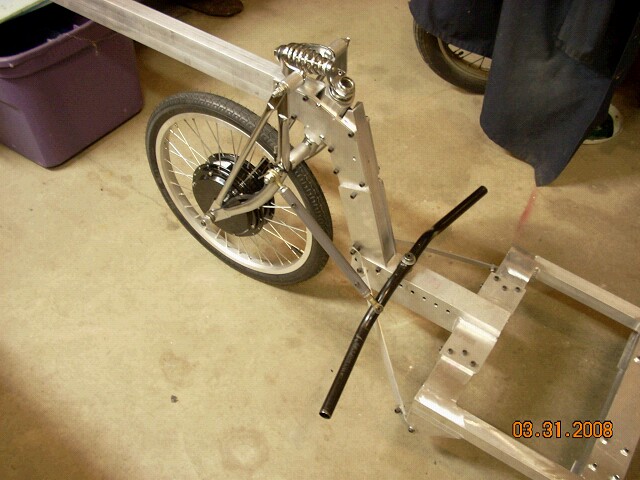
Rolling Chassis 4-3-08
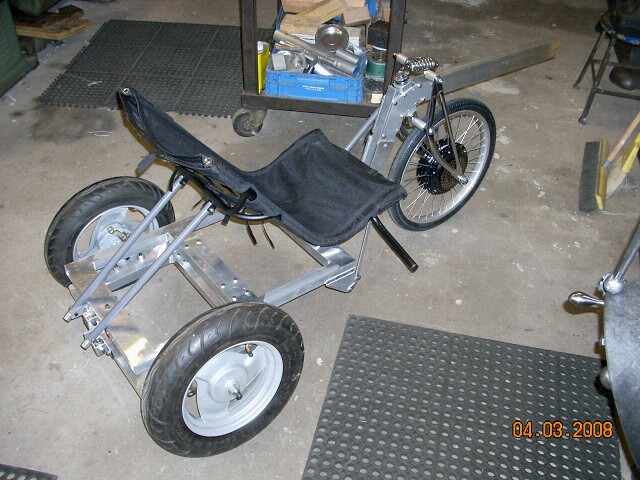
Ready for First Electric Test Ride 4-5-08
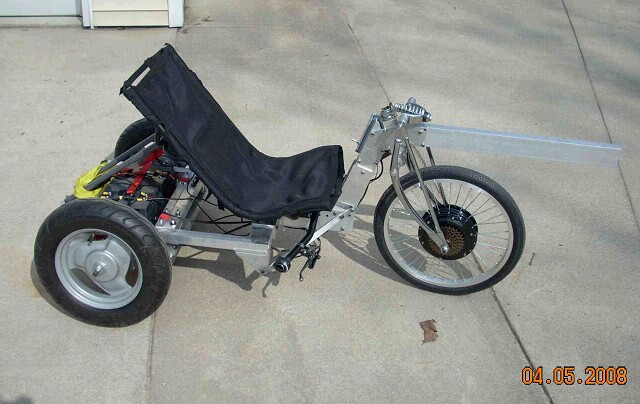
Relaxing in the Sun 4-6-08
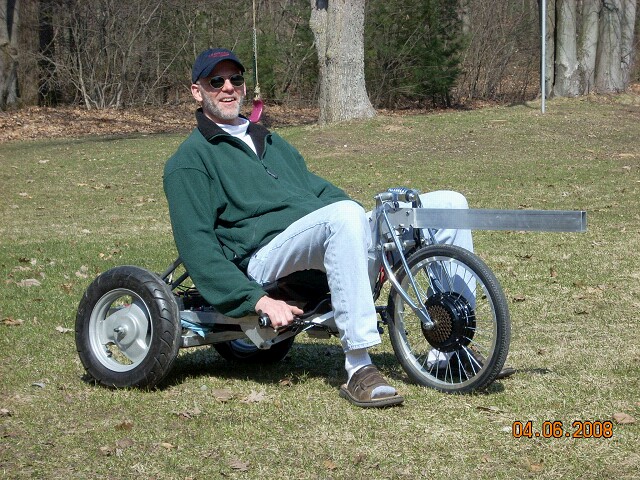
April 10, 2008 Front Wheel Drive Human Power! (Modified Roller Blade wheels serve as idlers).
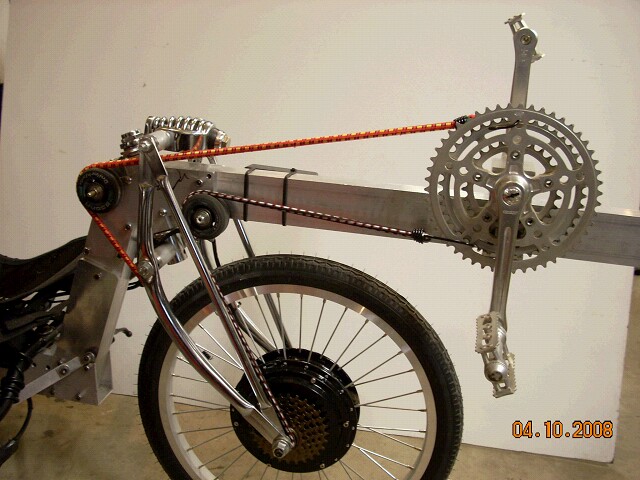
April 12, 2008 Human/Electric Chassis
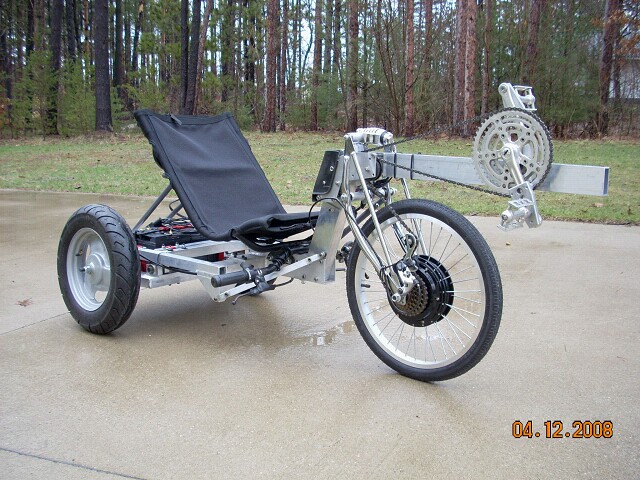
|
Sail Trike Observations, Design Concerns, Things to try 4-15-08 |
|
Sparrow Hub motor is under-powered for this vehicle. It has poor hill climbing and acceleration. The vehicle is not “fun” to ride. It’s max. electric speed is just over 20 mph. |
|
Vehicle is too low in city traffic and parking lots. It has poor visibility in traffic (It gives a good view of car hub caps and bumpers). It’s hard for rider to see around/over cars and for cars to see vehicle. But, it rides nice and safe on country roads and bike paths. |
|
How will Vehicle perform with wind power? What size sail is required? Will Body be enough or will vertical sail be required? |
|
I don’t know if the vehicle platform is stable at speeds over 20mph. I’ve experienced no stability, front end shimmy, or control problems up to 20 mph. But I am concerned about front end flex/flop at higher speeds. |
|
Front end flex is a concern. Will front end/forks bend or break in cornering? |
|
Will Front wheel collapse in higher speed turns? |
|
|
|
Pedaling with hub motor running makes vehicle rock back and forth sideways (sway) and makes the Springer fork bounce. |
|
Turning radius is a problem with the front wheel drive chain system. |
|
|
|
Rear suspension doesn’t seem to be required. The current 350 pounds per inch spring provides almost no rear suspension. Springer fork seems to be enough suspension for the vehicle. Could easily shave 8-10 pounds off vehicle weight by removing rear suspension. |
|
|
|
I have not experimented with smaller rear suspension spring to see how it works WITH a rear suspension. |
|
I have not tried to ride it without batteries as purely HPV. |
|
Using Chinese rear wheels was a mistake in that I had a lot of rework to fix their quality problems. I should have used Honda moped wheels. Better quality. |
|
Supporting the rear wheels both ends of the axle offers several advantages:
|
|
Moped wheels don’t need to be mounted with 5 degree angle. Bicycle wheels probably should be. Getting the 5 degree angle is a manufacturing pain in the ass. |
|
Rear Moped tire width of 3” wide is nice. 3.5” width is overkill. 10” moped wheels seem to have low rolling resistance (the vehicle coasts a long way), have great brakes, but brakes tend to lock up in heavy braking. The moped wheels are relatively heavy. |
|
Width of front end with Springer fork and wide hub motor may cause ergonomic problems with hips and knees. I felt some joint pain in the short rides I went on within 1-2 miles of start. Must be cautious! |
|
Springer fork May not be required if connection point for front end is hinged and springs are inserted as diagonal support members. |
|
Storage space should have been addressed more carefully during the design phase. How much cargo space is required? Where will space be? Will support brackets for seat/body get in way of storage? Where will vertical sail be mounted? |
|
15th gear is at least 2 gears to low for max SPARROW hub motor. |
|
Getting 30-35mph electric powered speed with this vehicle requires an investment of $1,100 in electrical components. This is quite near the price point for an E-tek or Perm-132 motor. The E-tek and Perm-132 are a little harder to integrate because they require sprockets and chain drive, but provide 8 hp more available power!
For a 30-35mph vehicle the Crystalyne motor option saves up to 20 pounds on vehicle weight, is MUCH easier to integrate, and is much easier to wire. But, only costs $200 less and has half the horse power. |
|
In reverse, the human power pedals turn backwards. This is inconvenient for the rider. The chain jams on pulleys in reverse (should be easily fixed by some tweaking). When not pedaling, the freewheel hub is freewheeling/clicking; how much energy does this use? |
|
Performance Data: Max speed: 22mph Range: 13 miles at 15 mph with 48V, 20 Amp Hour batteries (with one of the 4 batteries being weak) But, I suspect with strong batteries range will be similar to my motorcycle. Vehicle Weight without batteries: 90# Battery weight: 60# Rider: 185# Gross Vehicle Weight during testing: 335#
|
|
Opportunities: If I were to remove the Human power, I could steer vehicle with feet and have hands free for moving sail. Also, without human power, the nose of canopy could be mounted lower giving a sleeker look. |
|
Material Costs to date:
|
|
|
|
NEXT STEPS: |
|
1. Review, tweek, improve and test concerns, worries, etc. of items listed above. |
|
2. Experiment with various shell building materials and methods. Build a sail, build a shell for sail trike, electric motorcycle and 3 wheel motorcycle. |
|
3. Build a few electric motorcycles with dustbin fairings for sale to fund this Summer? |
|
4. Finish Sail Trike |

